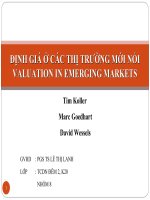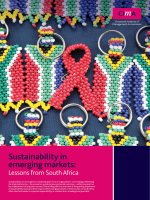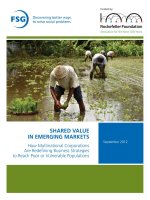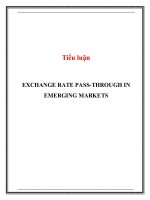new perspectives on investing in Emerging Market
Bạn đang xem bản rút gọn của tài liệu. Xem và tải ngay bản đầy đủ của tài liệu tại đây (340.35 KB, 17 trang )
Global Capital Market – Lecture 1W
Capital Market Theories
Emerging Market Finance CAU MBA
CAU
Wonil Lee, Ph.D, & CFA
New Perspectives on
Investing in EM
April, 2015
What makes investing in EM unique?
Should diversification always reduce portfolio risk?
Should the principles of investing in the US or the UK apply to EM?
Should EM investing always demand higher expected returns?
Although the fundamental behavior of participants in capital markets is
the same, EM contain unique governmental and other institutional
features that create distinct differences in the way investors must
approach their investment strategies.
Emerging Market Overview
3
* Source : MSCI
Capital Market Theories
1863, NYSE
1959
, Markovitz Model
1964, CAPM
1974, ERISA
1997,
Asian Currency
Crisis
2002, Nasdaq
Bubble
1987, Black Monday
1962, DDM
1973, Black &
Scholes Model
2007, US Sub Prime
Non normality in Returns
It is generally accepted that EM stock returns are not normally
distributed.
Extreme returns are more frequent than under a normal distribution,
which results in a fat-tailed distribution
These return distribution violate the normality assumption in the mean-
variance analysis framework commonly used in portfolio theory
Positively or negatively skewed returns are a result of company
ownership, corporate governance, and opaqueness. This also
contribute to synchronicity of stock market returns
And this is why financial theories are seriously not working in EM
The Market Synchronicity Puzzle
Traditional portfolio theory suggests that the risk of a security can be
divided into 2 components: market risk and company specific risk.
One measure of the importance of market risk is the percentage of
stocks in the market that move together over a particular period.
A market in which all stocks move in the same direction is said to
maintain high market synchronicity. Academic researches have found
that EM markets tends to have much higher market synchronicity than
developed markets.
In the US, the market synchronicity is around 57% while in Malaysia,
China, Poland, and Korea record 75%, 80%, 83%, and 70%,
respectively.
Information Inequities (Asymmetry)
Significant information inequities in EM among investors
Many of the institutional mechanisms for information dissemination in
developed markets are commonly missing in EM as individual investors
are majority of the EM
Efficient market hypothesis are generally weaker in EM
Outside investors receive only market wide news which results in
higher synchronicity of the market – usually big information asymmetry
in EM between insiders and outsiders
This information asymmetry create an uneven playing fields that
fundamentally affects investing decisions.
Insider Trading Regulations
Unlike developed markets, EM stock price is not changing in
accordance with the information. In other words, semi-strong form
Efficient Market Hypothesis cannot be proved
In many EM, trading based on material non-public information seems to
be easier than developed market and information dissemination by
analysts are not transparent and efficient
Last year, CJ E&M case was one of the example that Korean market is
still considered as EM
Empirical findings support the notion that unprosecuted insider trading
makes the information in equities even worse
Any Information Advantage?
There are mixed literature conclusion about information advantage of
domestic vs foreign investors
Some research argue domestic investors have information advantage
over foreign because of geographic location and home advantage while
some other research conclude that foreign investors (from developed
market) tend to have better information about broader market timing
and sector selection thanks to investment know-hows.
Current academic thinking is that geographic location is particularly
important in that local investors in EM naturally have an information
advantage over foreigners.
Another reason for information inequities is lack of transparency of
earnings disclosure resulting from poor accounting standards, lack of
credible auditing, and bad corporate governance practices in EM
Many Korean investors are using foreign local managers when they
invest overseas market
Market illiquidity
Another explanation for the synchronicity effect in EM is the presence
of abnormal illiquidity and other forms of transaction costs
Empirical research confirm that EM securities are commonly more
illiquid even if each EM has big difference
Transaction cost is relatively higher for EM and for foreign investors
It is widely accepted that illiquid assets and assets with high transaction
costs generally trade at a discount to their expected cash flow
EM illiquidity premium tends to decline once the market is opened up to
outside investors
This could be one of the reason why Korean stocks are traded at
discount to developed markets
One thing that could be found easily in EM is lack of protection from
investor expropriation, especially foreign investors
Controlling shareholders expropriation problem is the major corporate
governance issues in EM
Lower dividend payout, wealth transfer from shareholders to
controlling shareholders, restrictions on voting rights, lack of
independence of the BoD, etc.
Investors should understand EM legal system in order not to be
abused
Nationalism sometimes provoke serous anti-foreign investor
sentiment which will limit foreigners’ investment in EM
Poor Investor Protection
EM countries companies tend to have less transparent corporate
governance compared with developed market
As corporate governance is important for investment returns EM
investing return could be affected significantly from the corporate
governance practices in each EM countries
Over the past 20 years, there were many cases like this happening in
many EM and even developed markets
Across the globe, capital markets are becoming more integrated, and
this increasing integration is reducing synchronicity of EM.
Corporate Governance matters…
Although corporate governance practices are improving, typical EM
countries have some bad practices:
1. Management uses its control for perquisite consumption
2. Company shares are owned by another company that exerts control
similar to Keiretsu System in Japan
3. Creditor rights are often strong to the detriment of shareholders
Legal system is also generally weaker in EM in terms of protecting
minority shareholders especially foreign investors
Nationalism could provoke un-realistic problem for foreign investors
Improvements in corporate governance of emerging market companies
increase shareholder wealth, company valuation, and investor interest.
Typical EM Practices
Midopa vs Peregrine: 1997
0
10,000
20,000
30,000
40,000
50,000
100,000
600,000
1,100,000
1,600,000
2,100,000
2,600,000
Volume
Price
97년 2월 24일
미도파 400억원 규모의
공모 신주인수권부사채
(BW) 발행
97년 1월
외국자본(동방페레그린
증권) 미도파주식 매집
사실 확인
(거래량)
Nov-96 Jan-97 Mar-97 May-97
(주가)
1,000
51,000
101,000
151,000
201,000
251,000
301,000
2002-01 2002-10 2003-07 2004-04 2005-01 2005-10 2006-07 2007-04 2008-01
(원)
(Won)
SK (005830 KS)
Apr 2003
Sovereign acquires 6.14% of SK
shares in March and 8.85% in
April, totaling 14.99% and
KRW176.8 billion in gross amount.
Jul 2005
On Jul 15, Sovereign sell all of SK
shares, or 14.82%, over the
counter to an anonymous buyer at
KRW49,011, 7% discount off the
day's closing price of KRW52,700.
Profit earned from the sellout is
estimated to be KRW800 billion.
Nov 2006
SK buys 13 million shares, or 10%
of total available shares, of
treasury stock at KRW66,400
each at the same time it
announces plans to sell KRW470
billion to improve its financial
structure.
Jan 2007
SK forms a strategic partnership with
JX Nippon Oil & Energy and buys
each others shares, 1% SK share to
0.98% JK Nippon share ratio.
Apr 2007
Former SK spins
off petrochemical
unit SK Energy.
21,000
31,000
41,000
51,000
61,000
71,000
81,000
2005-01 2005-10 2006-07 2007-04
(원)
(Won)
KT&G (033780 KS)
Feb 2006
Icahn coalition suggests
acquisition of KY%G at KRW
60,000 a share
Mar 2006
KT&G appoints Lichtenstein as
external board director
Dec 2006
Icahn coalition sells 4.75% of
KT&G shares at a 3.8% discount
from the closing price of the
previous day at KRW 60,700 per
share
Jul 2007
Shinhan Bank acquires 2.3%
of KT&G shares OTC
Oct 2007
KT&G acquires KRW
202billion of treasury shares
1,500
2,500
3,500
4,500
5,500
6,500
7,500
2007-01 2007-07 2008-01 2008-07 2009-01 2009-07
(Yen)
J-Power (9513 JP)
Apr 2008
TCI's request is rejected on grounds that
TCI has presented a one-sided view
Dec 2007
UK-based activist fund TCI demands
J-Power to improve corporate
governance, to boost shareholder
returns and sell cross-shareholdings
as part of its business proposal
Jan 2008
TCI demands J-Power to draw up
detailed plans addressing profitability
and capital spending. TCI requests to
include external board members, a
reduction in director compensation, to
sell off shares held under cross-
holding arrangements and to accept
two Children Investment's officials as
outside directors









